Analysis of Management Issues in Tourism and Hospitality Industry
VerifiedAdded on 2023/01/23
|5
|1162
|76
Report
AI Summary
This report provides a detailed analysis of various management issues within the tourism and hospitality industry. It examines challenges across operational, human resource, financial, and product/market contexts. Operational issues include labor shortages and cost containment. Human resource challenges involve skill gaps, recruitment and retention, and employee training and development. The financial context covers risk management and working capital issues. Product and market challenges include increased competition and the need for personalized services. The report references several academic sources to support its findings and provides insights into the complexities of managing these challenges in the industry. This report is available on Desklib, a platform offering AI-based study tools for students.
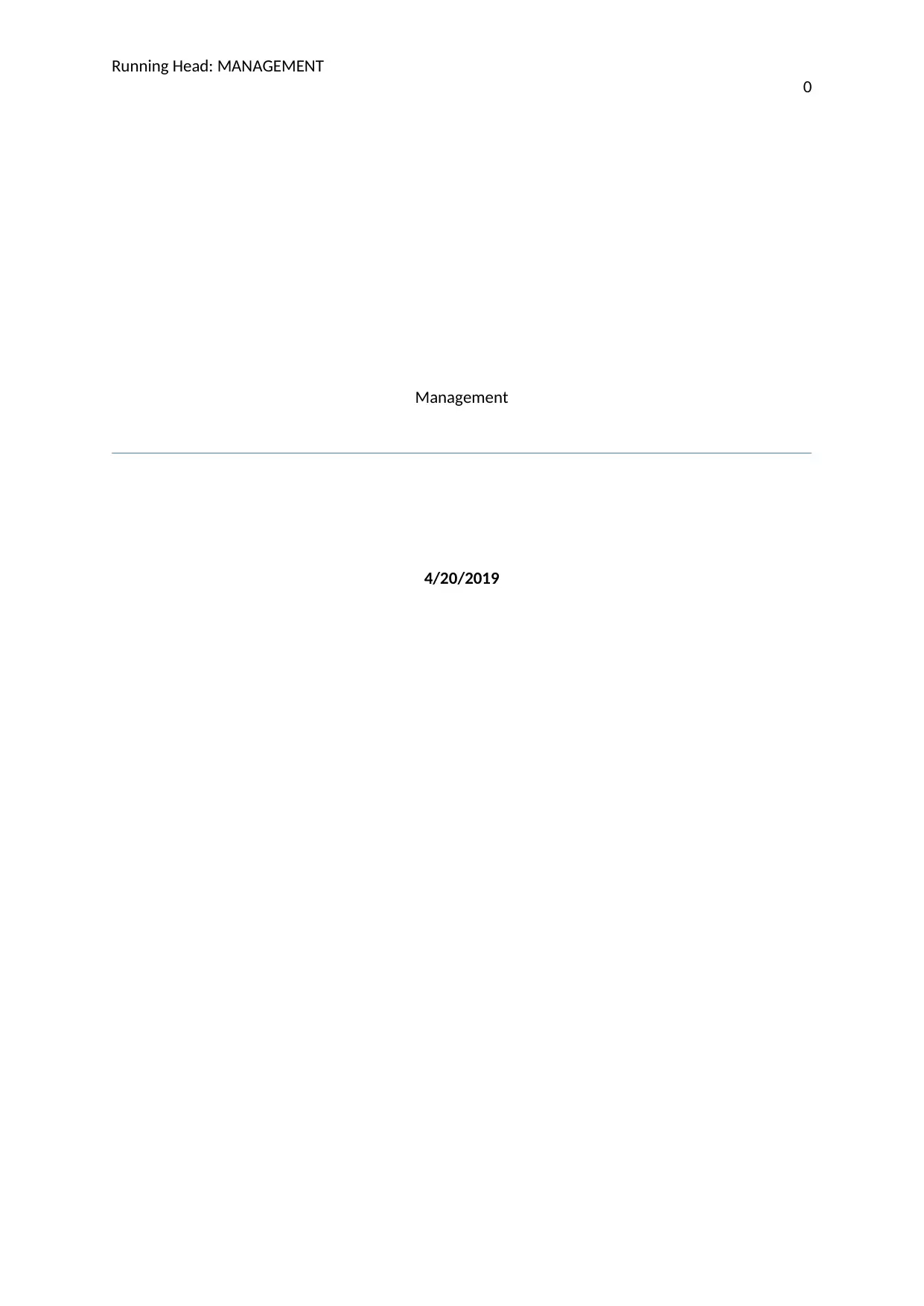
Running Head: MANAGEMENT
0
Management
4/20/2019
0
Management
4/20/2019
Paraphrase This Document
Need a fresh take? Get an instant paraphrase of this document with our AI Paraphraser
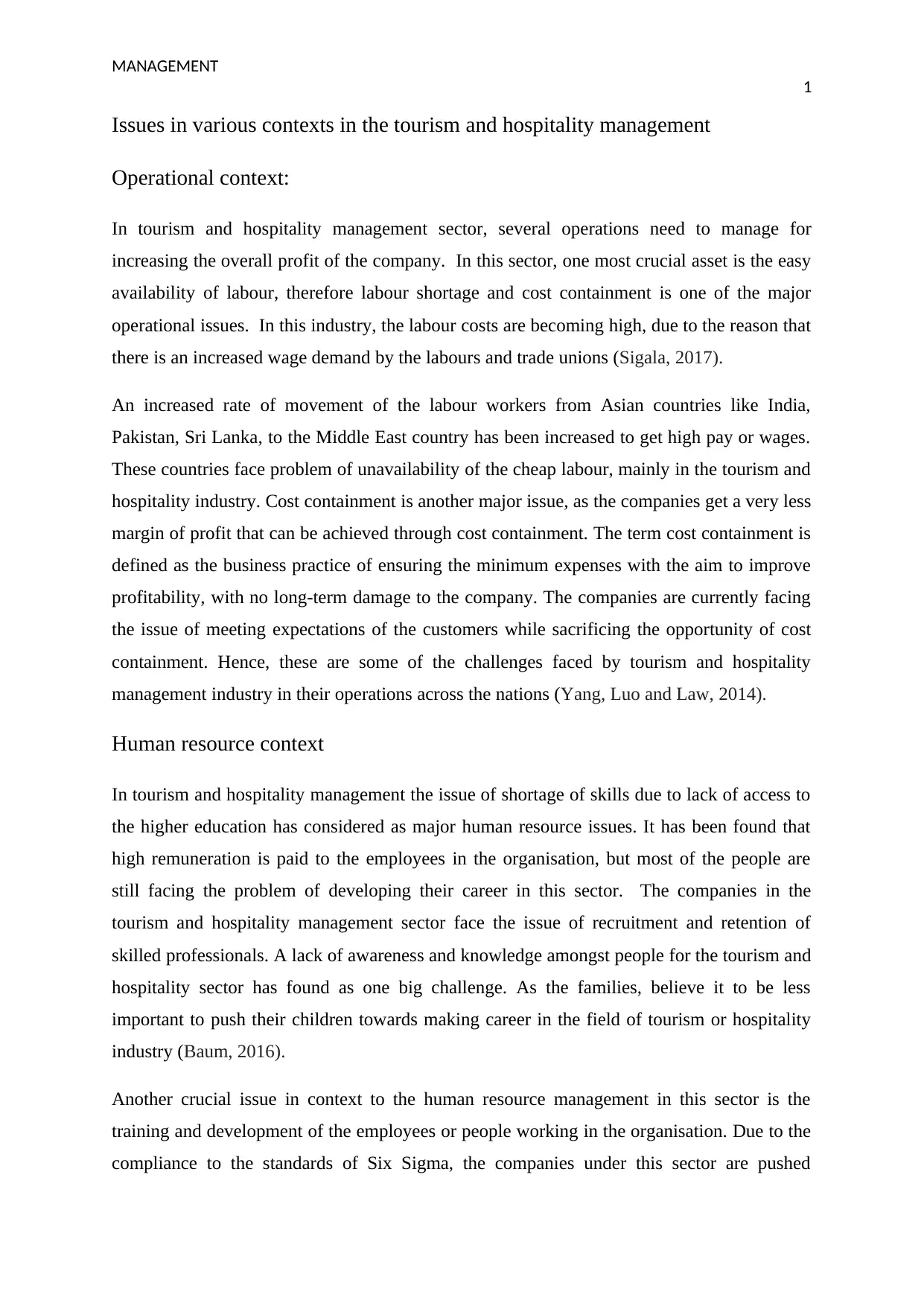
MANAGEMENT
1
Issues in various contexts in the tourism and hospitality management
Operational context:
In tourism and hospitality management sector, several operations need to manage for
increasing the overall profit of the company. In this sector, one most crucial asset is the easy
availability of labour, therefore labour shortage and cost containment is one of the major
operational issues. In this industry, the labour costs are becoming high, due to the reason that
there is an increased wage demand by the labours and trade unions (Sigala, 2017).
An increased rate of movement of the labour workers from Asian countries like India,
Pakistan, Sri Lanka, to the Middle East country has been increased to get high pay or wages.
These countries face problem of unavailability of the cheap labour, mainly in the tourism and
hospitality industry. Cost containment is another major issue, as the companies get a very less
margin of profit that can be achieved through cost containment. The term cost containment is
defined as the business practice of ensuring the minimum expenses with the aim to improve
profitability, with no long-term damage to the company. The companies are currently facing
the issue of meeting expectations of the customers while sacrificing the opportunity of cost
containment. Hence, these are some of the challenges faced by tourism and hospitality
management industry in their operations across the nations (Yang, Luo and Law, 2014).
Human resource context
In tourism and hospitality management the issue of shortage of skills due to lack of access to
the higher education has considered as major human resource issues. It has been found that
high remuneration is paid to the employees in the organisation, but most of the people are
still facing the problem of developing their career in this sector. The companies in the
tourism and hospitality management sector face the issue of recruitment and retention of
skilled professionals. A lack of awareness and knowledge amongst people for the tourism and
hospitality sector has found as one big challenge. As the families, believe it to be less
important to push their children towards making career in the field of tourism or hospitality
industry (Baum, 2016).
Another crucial issue in context to the human resource management in this sector is the
training and development of the employees or people working in the organisation. Due to the
compliance to the standards of Six Sigma, the companies under this sector are pushed
1
Issues in various contexts in the tourism and hospitality management
Operational context:
In tourism and hospitality management sector, several operations need to manage for
increasing the overall profit of the company. In this sector, one most crucial asset is the easy
availability of labour, therefore labour shortage and cost containment is one of the major
operational issues. In this industry, the labour costs are becoming high, due to the reason that
there is an increased wage demand by the labours and trade unions (Sigala, 2017).
An increased rate of movement of the labour workers from Asian countries like India,
Pakistan, Sri Lanka, to the Middle East country has been increased to get high pay or wages.
These countries face problem of unavailability of the cheap labour, mainly in the tourism and
hospitality industry. Cost containment is another major issue, as the companies get a very less
margin of profit that can be achieved through cost containment. The term cost containment is
defined as the business practice of ensuring the minimum expenses with the aim to improve
profitability, with no long-term damage to the company. The companies are currently facing
the issue of meeting expectations of the customers while sacrificing the opportunity of cost
containment. Hence, these are some of the challenges faced by tourism and hospitality
management industry in their operations across the nations (Yang, Luo and Law, 2014).
Human resource context
In tourism and hospitality management the issue of shortage of skills due to lack of access to
the higher education has considered as major human resource issues. It has been found that
high remuneration is paid to the employees in the organisation, but most of the people are
still facing the problem of developing their career in this sector. The companies in the
tourism and hospitality management sector face the issue of recruitment and retention of
skilled professionals. A lack of awareness and knowledge amongst people for the tourism and
hospitality sector has found as one big challenge. As the families, believe it to be less
important to push their children towards making career in the field of tourism or hospitality
industry (Baum, 2016).
Another crucial issue in context to the human resource management in this sector is the
training and development of the employees or people working in the organisation. Due to the
compliance to the standards of Six Sigma, the companies under this sector are pushed
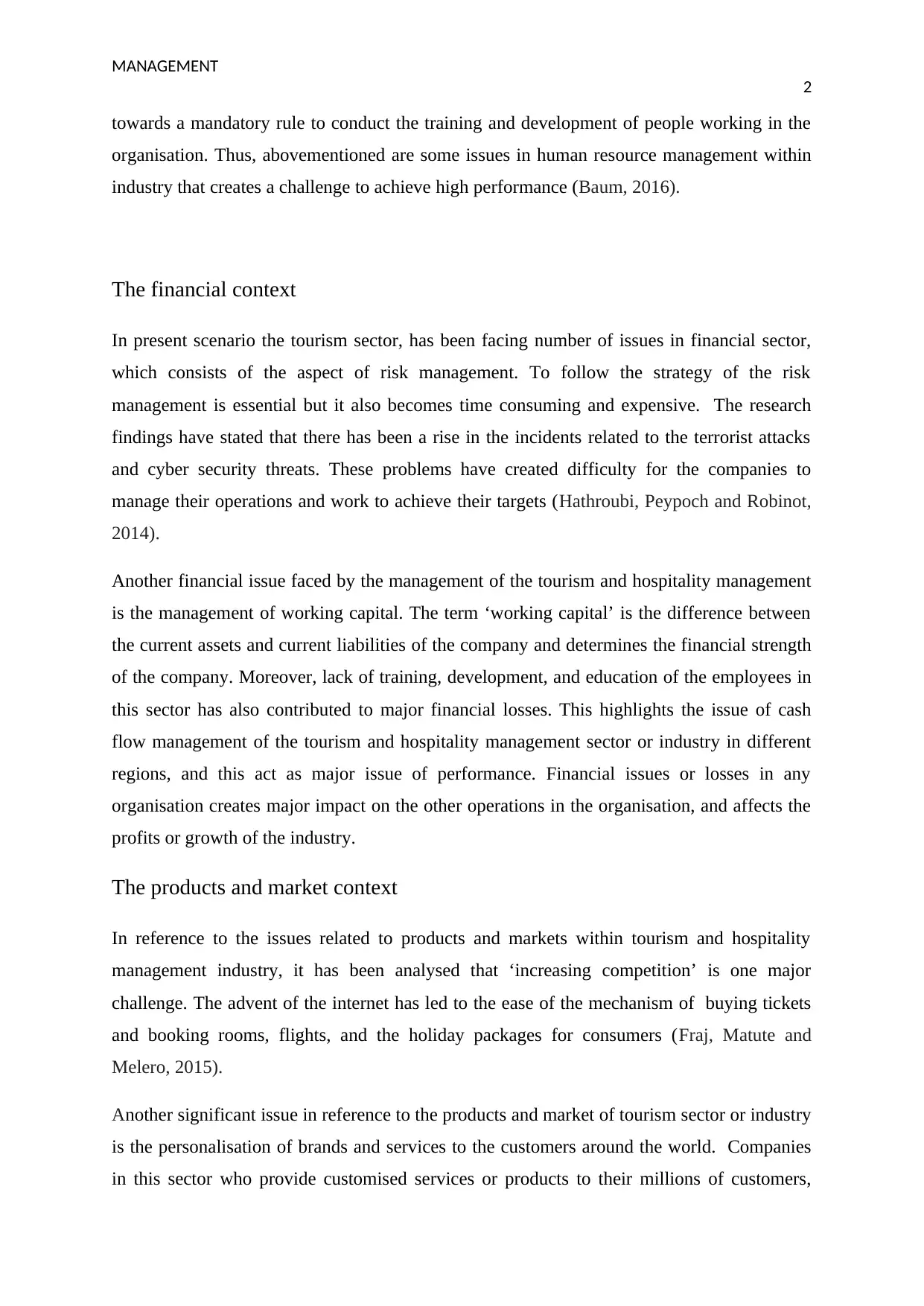
MANAGEMENT
2
towards a mandatory rule to conduct the training and development of people working in the
organisation. Thus, abovementioned are some issues in human resource management within
industry that creates a challenge to achieve high performance (Baum, 2016).
The financial context
In present scenario the tourism sector, has been facing number of issues in financial sector,
which consists of the aspect of risk management. To follow the strategy of the risk
management is essential but it also becomes time consuming and expensive. The research
findings have stated that there has been a rise in the incidents related to the terrorist attacks
and cyber security threats. These problems have created difficulty for the companies to
manage their operations and work to achieve their targets (Hathroubi, Peypoch and Robinot,
2014).
Another financial issue faced by the management of the tourism and hospitality management
is the management of working capital. The term ‘working capital’ is the difference between
the current assets and current liabilities of the company and determines the financial strength
of the company. Moreover, lack of training, development, and education of the employees in
this sector has also contributed to major financial losses. This highlights the issue of cash
flow management of the tourism and hospitality management sector or industry in different
regions, and this act as major issue of performance. Financial issues or losses in any
organisation creates major impact on the other operations in the organisation, and affects the
profits or growth of the industry.
The products and market context
In reference to the issues related to products and markets within tourism and hospitality
management industry, it has been analysed that ‘increasing competition’ is one major
challenge. The advent of the internet has led to the ease of the mechanism of buying tickets
and booking rooms, flights, and the holiday packages for consumers (Fraj, Matute and
Melero, 2015).
Another significant issue in reference to the products and market of tourism sector or industry
is the personalisation of brands and services to the customers around the world. Companies
in this sector who provide customised services or products to their millions of customers,
2
towards a mandatory rule to conduct the training and development of people working in the
organisation. Thus, abovementioned are some issues in human resource management within
industry that creates a challenge to achieve high performance (Baum, 2016).
The financial context
In present scenario the tourism sector, has been facing number of issues in financial sector,
which consists of the aspect of risk management. To follow the strategy of the risk
management is essential but it also becomes time consuming and expensive. The research
findings have stated that there has been a rise in the incidents related to the terrorist attacks
and cyber security threats. These problems have created difficulty for the companies to
manage their operations and work to achieve their targets (Hathroubi, Peypoch and Robinot,
2014).
Another financial issue faced by the management of the tourism and hospitality management
is the management of working capital. The term ‘working capital’ is the difference between
the current assets and current liabilities of the company and determines the financial strength
of the company. Moreover, lack of training, development, and education of the employees in
this sector has also contributed to major financial losses. This highlights the issue of cash
flow management of the tourism and hospitality management sector or industry in different
regions, and this act as major issue of performance. Financial issues or losses in any
organisation creates major impact on the other operations in the organisation, and affects the
profits or growth of the industry.
The products and market context
In reference to the issues related to products and markets within tourism and hospitality
management industry, it has been analysed that ‘increasing competition’ is one major
challenge. The advent of the internet has led to the ease of the mechanism of buying tickets
and booking rooms, flights, and the holiday packages for consumers (Fraj, Matute and
Melero, 2015).
Another significant issue in reference to the products and market of tourism sector or industry
is the personalisation of brands and services to the customers around the world. Companies
in this sector who provide customised services or products to their millions of customers,
⊘ This is a preview!⊘
Do you want full access?
Subscribe today to unlock all pages.

Trusted by 1+ million students worldwide
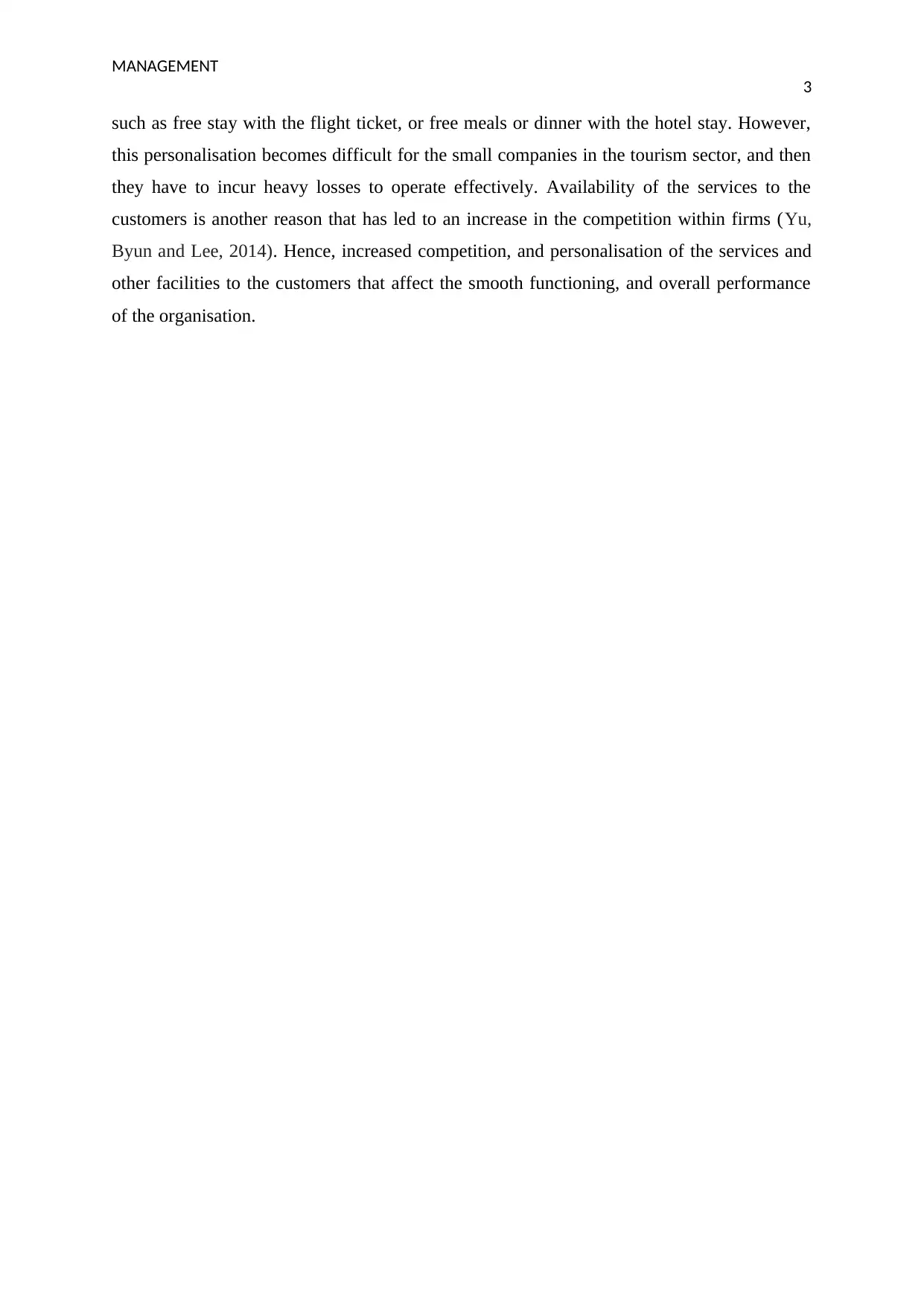
MANAGEMENT
3
such as free stay with the flight ticket, or free meals or dinner with the hotel stay. However,
this personalisation becomes difficult for the small companies in the tourism sector, and then
they have to incur heavy losses to operate effectively. Availability of the services to the
customers is another reason that has led to an increase in the competition within firms (Yu,
Byun and Lee, 2014). Hence, increased competition, and personalisation of the services and
other facilities to the customers that affect the smooth functioning, and overall performance
of the organisation.
3
such as free stay with the flight ticket, or free meals or dinner with the hotel stay. However,
this personalisation becomes difficult for the small companies in the tourism sector, and then
they have to incur heavy losses to operate effectively. Availability of the services to the
customers is another reason that has led to an increase in the competition within firms (Yu,
Byun and Lee, 2014). Hence, increased competition, and personalisation of the services and
other facilities to the customers that affect the smooth functioning, and overall performance
of the organisation.
Paraphrase This Document
Need a fresh take? Get an instant paraphrase of this document with our AI Paraphraser
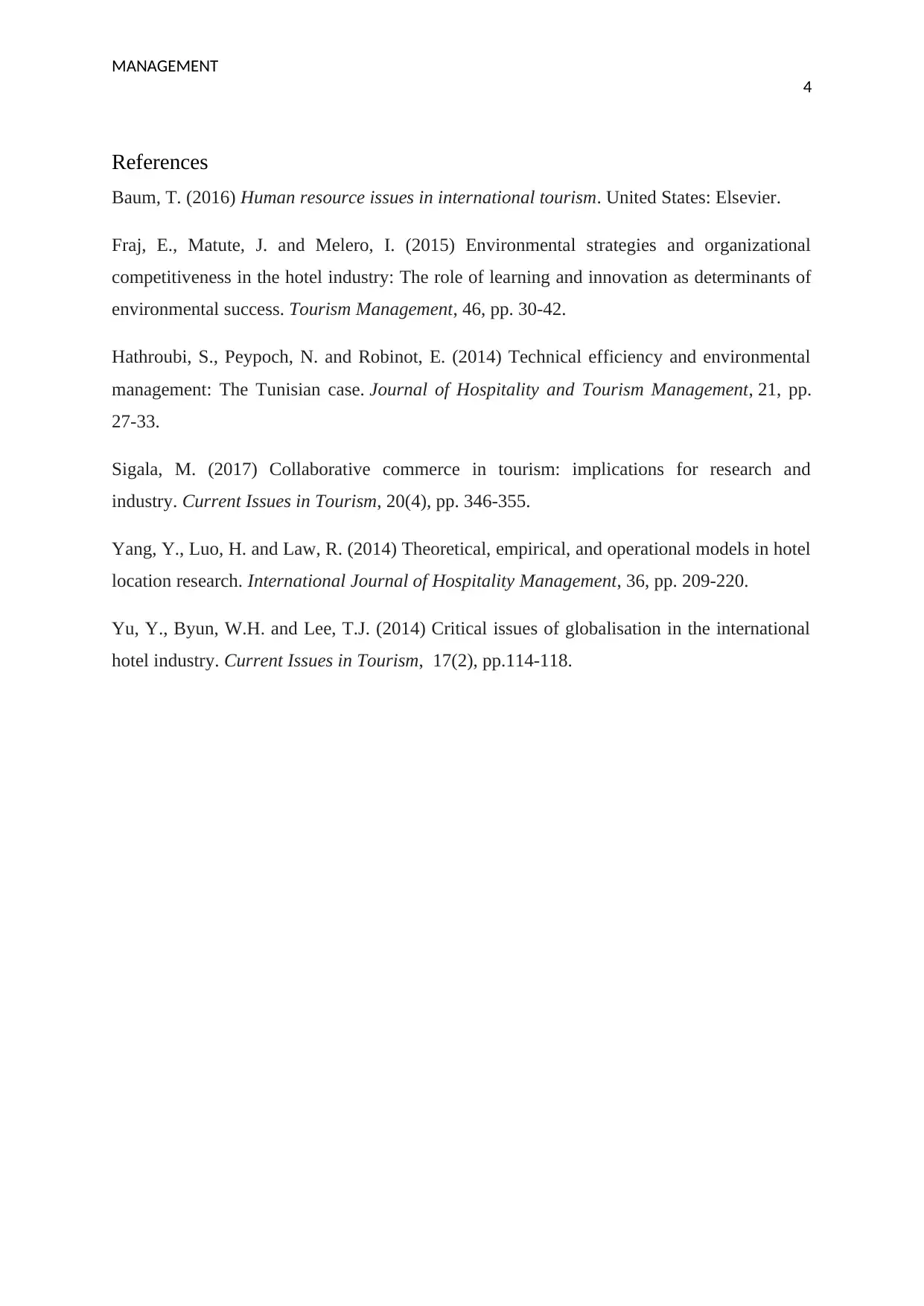
MANAGEMENT
4
References
Baum, T. (2016) Human resource issues in international tourism. United States: Elsevier.
Fraj, E., Matute, J. and Melero, I. (2015) Environmental strategies and organizational
competitiveness in the hotel industry: The role of learning and innovation as determinants of
environmental success. Tourism Management, 46, pp. 30-42.
Hathroubi, S., Peypoch, N. and Robinot, E. (2014) Technical efficiency and environmental
management: The Tunisian case. Journal of Hospitality and Tourism Management, 21, pp.
27-33.
Sigala, M. (2017) Collaborative commerce in tourism: implications for research and
industry. Current Issues in Tourism, 20(4), pp. 346-355.
Yang, Y., Luo, H. and Law, R. (2014) Theoretical, empirical, and operational models in hotel
location research. International Journal of Hospitality Management, 36, pp. 209-220.
Yu, Y., Byun, W.H. and Lee, T.J. (2014) Critical issues of globalisation in the international
hotel industry. Current Issues in Tourism, 17(2), pp.114-118.
4
References
Baum, T. (2016) Human resource issues in international tourism. United States: Elsevier.
Fraj, E., Matute, J. and Melero, I. (2015) Environmental strategies and organizational
competitiveness in the hotel industry: The role of learning and innovation as determinants of
environmental success. Tourism Management, 46, pp. 30-42.
Hathroubi, S., Peypoch, N. and Robinot, E. (2014) Technical efficiency and environmental
management: The Tunisian case. Journal of Hospitality and Tourism Management, 21, pp.
27-33.
Sigala, M. (2017) Collaborative commerce in tourism: implications for research and
industry. Current Issues in Tourism, 20(4), pp. 346-355.
Yang, Y., Luo, H. and Law, R. (2014) Theoretical, empirical, and operational models in hotel
location research. International Journal of Hospitality Management, 36, pp. 209-220.
Yu, Y., Byun, W.H. and Lee, T.J. (2014) Critical issues of globalisation in the international
hotel industry. Current Issues in Tourism, 17(2), pp.114-118.
1 out of 5
Related Documents
Your All-in-One AI-Powered Toolkit for Academic Success.
+13062052269
info@desklib.com
Available 24*7 on WhatsApp / Email
![[object Object]](/_next/static/media/star-bottom.7253800d.svg)
Unlock your academic potential
Copyright © 2020–2025 A2Z Services. All Rights Reserved. Developed and managed by ZUCOL.





